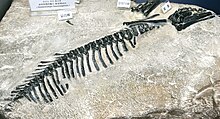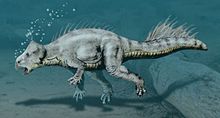Koreaceratops
| Koreaceratops Temporal range: Early Cretaceous,
| |
|---|---|

| |
| Holotype specimen | |

| |
| Koreaceratops hypothetically restored as semi-aquatic | |
| Scientific classification | |
| Kingdom: | Animalia |
| Phylum: | Chordata |
| Clade: | Dinosauria |
| Order: | †Ornithischia |
| Suborder: | †Ceratopsia |
| Infraorder: | †Neoceratopsia |
| Genus: | †Koreaceratops Lee et al., 2011 |
| Species: | †K. hwaseongensis
|
| Binomial name | |
| †Koreaceratops hwaseongensis Lee et al., 2011
| |
Koreaceratops is a genus of basal ceratopsian dinosaur discovered in Albian-age Lower Cretaceous rocks of South Korea. It is based on KIGAM VP 200801, an articulated series of 36 caudal vertebrae associated with partial hind limbs and ischia. This specimen was found in a sandstone block that had been incorporated into the Tando dam at Hwaseong City; the way the specimen is cut off suggests that more of it was present before quarrying. The dam was built in 1994, and the bones were first brought to the attention of paleontologists in 2008, after a public official noticed them. The specimen probably came from the lower Tando beds. The upper part of this informally named formation dates to 103 ± 0.5 million years ago. Koreaceratops was described by Yuong-Nam Lee and colleagues in 2011. The genus name is a combination of "Korea" and the Greek κέρας (keras) meaning 'horn' and ὄψις (opsis) meaning 'face'. The type species is K. hwaseongensis, named after Hwaseong City.[1]
Koreaceratops is notable for the tall neural spines on its caudal vertebrae, and for the structure of its astragalus. In some of the distal caudal vertebrae, the neural spines are over five times the height of the vertebral centra to which they attach. Lee et al. noted that several other ceratopsians also had tall neural spines on their caudals. As this trait appears in several branches of ceratopsians, Lee et al. postulated that the feature was independently evolved, perhaps as an adaptation for swimming. Lee et al. performed a phylogenetic analysis and found Koreaceratops to be positioned between Archaeoceratops and more derived ceratopsians.[1] A 2022 study however, suggests it is closer to Protoceratops than to earlier animals like Psittacosaurus and Archaeoceratops.[2]
Paleobiology[]
An examination of the bone histology of Koreaceratops published in 2022 suggests that the type specimen was roughly eight years old when it died. The same study suggests that Koreaceratops lived in a semiarid environment, and that microbial erosion is responsible for the poor preservation of its distinguishing features.[2]
See also[]
References[]
- ^ a b Lee, Yuong-Nam; Ryan, Michael J.; Kobayashi, Yoshitsugu (2011). "The first ceratopsian dinosaur from South Korea" (PDF). Naturwissenschaften. 98 (1): 39–49. Bibcode:2011NW.....98...39L. doi:10.1007/s00114-010-0739-y. PMID 21085924. S2CID 23743082.
- ^ a b Baag, Sung Jun; Lee, Yuong-Nam (1 June 2022). "Bone histology on Koreaceratops hwaseongensis (Dinosauria: Ceratopsia) from the Lower Cretaceous of South Korea". Cretaceous Research. 134: 105150. doi:10.1016/j.cretres.2022.105150. S2CID 246340350.
- Ceratopsians
- Early Cretaceous dinosaurs of Asia
- Albian life
- Fossils of South Korea
- Fossil taxa described in 2011
- Ornithischian genera
- Ornithischian stubs




